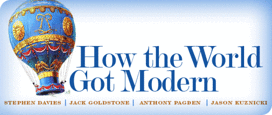Lead Essay
In this month’s lead essay, historian Stephen Davies tackles one of the biggest of big questions: How did the world we live in — the modern world — so radically and rapidly diverge from the world of our pre-modern ancestors? Davies starts with a multitude of proposed explanations and winnows them down to three: the advent of empirical science and engineering, a shift in cultural attitudes toward commerce and trade, and the development of the Westphalian system of nation-states. Yet these factors emerged over a century before modernity really took off. Why the lag? Davies argues that the missing ingredient was the unique climate of competition among ruling elites in Europe in the 17th and 18th centuries, which combined with the other elements to produce the scientific innovation and economic growth that created the modern world.
Response Essays
In his reply to Stephen Davies’ lead essay, Jack Goldstone argues that modernity was launched when “elites developed a new ‘engineering culture’ ” that departed sharply from European tradition. In order to gain from the commercial application of new knowledge by private entrepeneurs, Goldstone argues, political rulers were led to allow non-conformity with traditional religious authority and to “give up attempts to control the access of private firms and entrepreneurs to scientific knowledge and to market opportunities.” These developments helped overturn older ideas of absolute royal authority and guild privelege, which in turn contributed to the political and social revolutions of the 18th and 19th centuries and a decisive break from prior Western conceptions of society. Though the liberal idea of “a community of free individuals sovereign over a limited state” arose first in the West, political and economic liberalization do not require a commitment to pre-modern Western values, Goldstone concludes.
In his reply, UCLA historian Anthony Pagden doubts that the historical discontinuity created by the onset of modernity is “as sudden or as all-pervasive” as Stephen Davies makes it out to be. Pagden points both to much earlier and more recent changes that seem at least as dramatic as the changes between modern and pre-modern Europe, and he questions Davies’ revised periodization of history. Pagden agrees that the emergence of the scientific method partly accounts for “the rise of the West,” but “then we have to ask ourselves why it was that Copernicus, Galileo, Bacon, Descartes, Leibnitz, Pascal, Boyle, Newton, etc. were not Chinese or Mughal or Iranian or Arab.” Pagden submits that the answer is “the advent of secularism” following the post-Reformation sectarian wars, which drove “theological modes of reasoning forever from the public sphere.”
In his reply to Davies, Cato Unbound’s own Jason Kuznicki worries that the alleged gap between the beginning of distinctively modern thinking in the late 17th century and the economic and demographic takeoff in the late eighteenth century is no gap at all. “I’m tempted to invert the supposed gap,” Kuznicki writes, “and to suggest that in the earliest of early modernities … a set of social practices, and substantial concomitant rewards, generally arrived before any modern ideology existed to justify them.” Kuznicki notes that new ideas spread unevenly and over time, and he argues that the early emergence of upwardly mobile English and Dutch middle classes imply that “[i]f there was a modernity gap, its chief dimension was not temporal, but spatial.” Kuznicki suggests that, pace Davies, elites and their new ideas did not precipitate the rise of modernity, but played an intermediate role. Kuznicki challenges Davies to clarifiy “what exactly the elites are doing” in his story.

